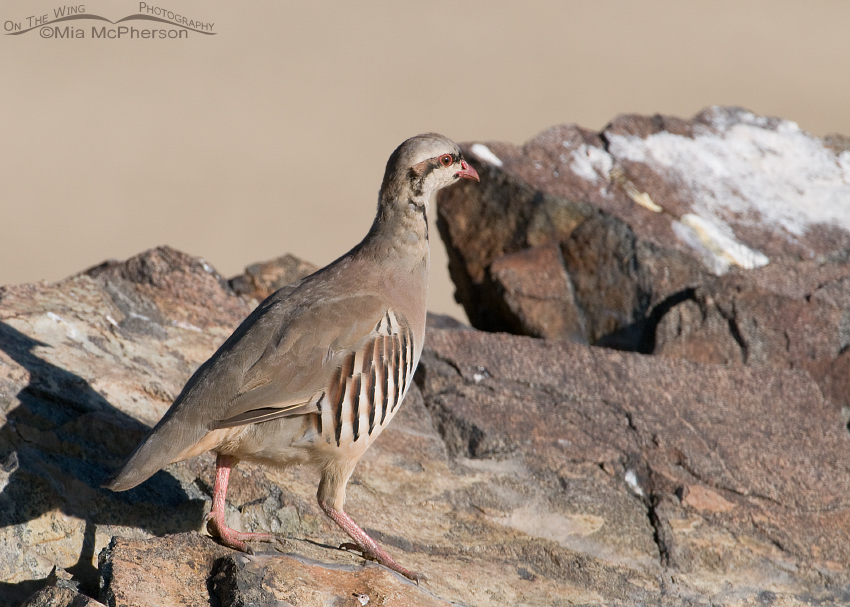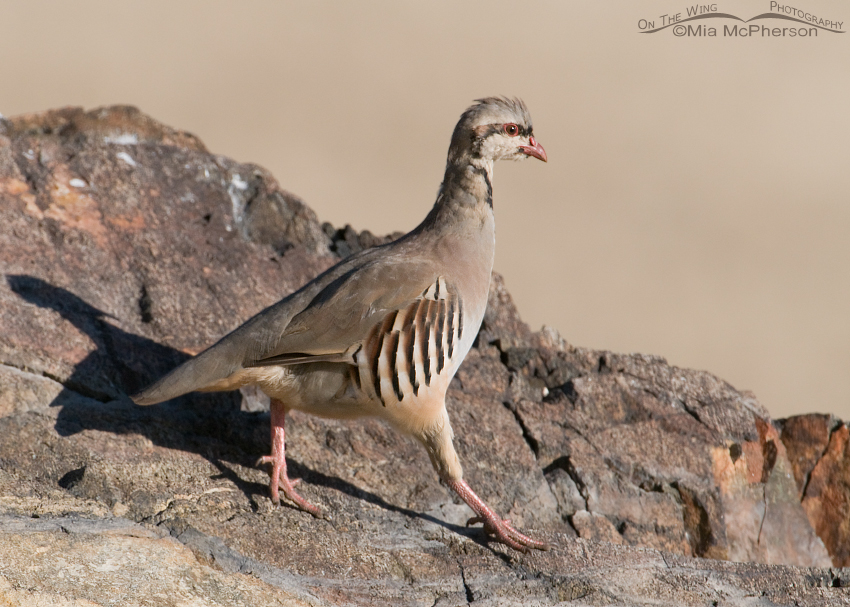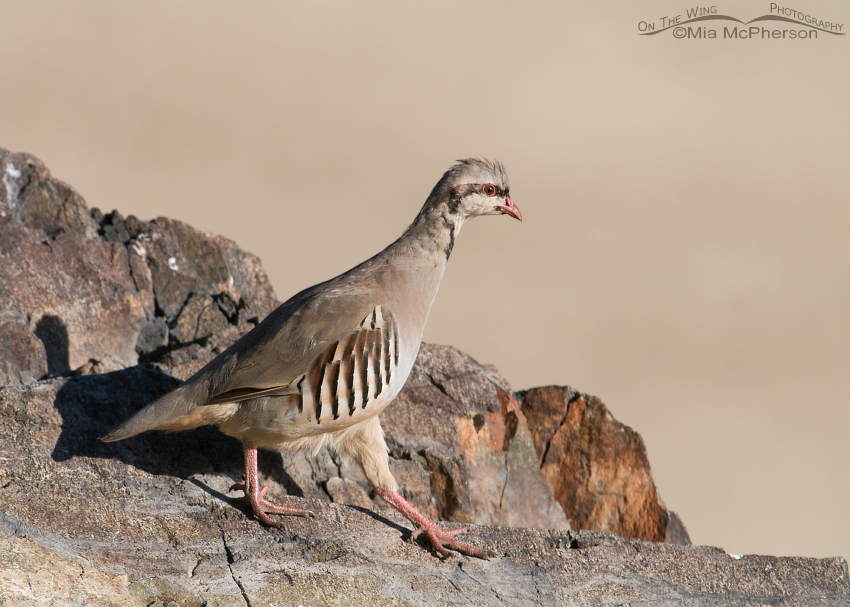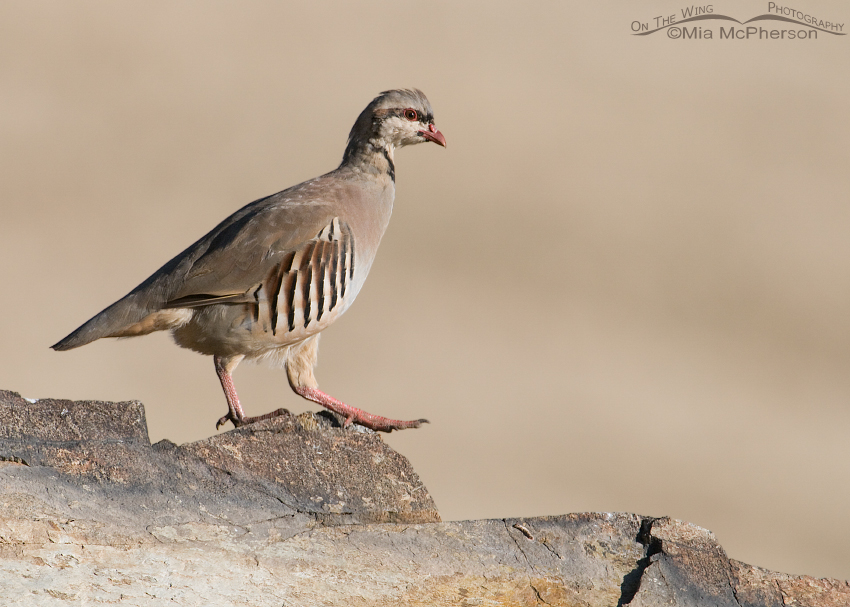 Young Chukar on rocks – Nikon D300, f7.1, 1/2000, ISO 640, +0.3 EV, Nikkor 200-300mm VR with 1.4x TC 350mm, natural light, not baited
Young Chukar on rocks – Nikon D300, f7.1, 1/2000, ISO 640, +0.3 EV, Nikkor 200-300mm VR with 1.4x TC 350mm, natural light, not baited
I have learned that you have to be prepared to be a bird photographer and additionally that you need to be fast because birds are free moving creatures. There are times that you simply don’t or won’t have time to change your camera’s settings.
This series of Chukar images that I am posting were taken in only two seconds, barely enough time to focus, lock on and shoot a burst of shots. At that moment it seemed a little longer than that but I double checked my file EXIF information (Exchangeable Image File) in Adobe Photoshop and two seconds was all I had with this young Chukar.
 Oh no, she spotted me – Nikon D300, f7.1, 1/1600, ISO 640, +0.3 EV, Nikkor 200-400mm VR with 1.4x TC at 350mm, natural light, not baited
Oh no, she spotted me – Nikon D300, f7.1, 1/1600, ISO 640, +0.3 EV, Nikkor 200-400mm VR with 1.4x TC at 350mm, natural light, not baited
I was fortunate that my camera’s settings at the time worked with these photos because there wasn’t even a second to spare to change them. Some times that works, some times it doesn’t. I’ve been on both sides of that stick.
 Young Chukar in a hurry – Nikon D300, f7.1, 1/1600, ISO 640, +0.3 EV, Nikkor 200-400mm VR with 1.4x TC at 350mm, natural light, not baited
Young Chukar in a hurry – Nikon D300, f7.1, 1/1600, ISO 640, +0.3 EV, Nikkor 200-400mm VR with 1.4x TC at 350mm, natural light, not baited
Being prepared = being fast. You never know when a wild bird might cross your path so quite often you have to make adjustments quickly on the “fly” (pardon the pun). This Chukar had scurried across the road to this lofty, rocky perch and after getting to the top of the rocks it headed east as fast as it seemed it could.
But if I had stopped even long enough to adjust my EV compensation or aperture this young Chukar would have been long gone and I would have lost the opportunity to photograph it.
 High stepping Chukar – Nikon D300, f7.1, 1/1250, ISO 640, +0.3 EV, Nikkor 200-400mm VR with 1.4x TC at 350mm, natural light, not baited
High stepping Chukar – Nikon D300, f7.1, 1/1250, ISO 640, +0.3 EV, Nikkor 200-400mm VR with 1.4x TC at 350mm, natural light, not baited
By estimating what your camera’s settings might need to be frequently out in the field you can increase your chances of getting the photos you desire. Birds that are nervous on approach might not allow you the time to adjust your EV before they take flight and you may lose the opportunity to photograph them.
 In a hurry – Nikon D300, f7.1, 1/1600, ISO 640, +0.3 EV, Nikkor 200-400mm VR with 1.4x TC at 350mm, natural light, not baited
In a hurry – Nikon D300, f7.1, 1/1600, ISO 640, +0.3 EV, Nikkor 200-400mm VR with 1.4x TC at 350mm, natural light, not baited
Knowing about your location in advance can help with some settings; for instance this location is well known to me, I know what angle I need to be at for the best light and I also know that the hill in the background is a long way from the rocks and that it will give the images a clean background.
 You looking at me? – Nikon D300, f7.1, 1/2000, ISO 640, +0.3 EV, Nikkor 200-400mm VR with 1.4x TC at 350mm, natural light, not baited
You looking at me? – Nikon D300, f7.1, 1/2000, ISO 640, +0.3 EV, Nikkor 200-400mm VR with 1.4x TC at 350mm, natural light, not baited
This young Chukar was in a hurry to join the rest of the Chukars that has already gone into the nearby cover of sagebrush at the base of the rocks, I can’t say I blame the bird with two big lenses aimed at it. I know I prefer being on the back side of the lens myself.
 Gotta go! – Nikon D300, f7.1, 1/2000, ISO 640, +0.3 EV, Nikkor 200-400mm VR with 1.4x TC at 350mm, natural light, not baited
Gotta go! – Nikon D300, f7.1, 1/2000, ISO 640, +0.3 EV, Nikkor 200-400mm VR with 1.4x TC at 350mm, natural light, not baited
It was a fun two seconds because I was prepared.
Mia


Being prepared is hard work but I can see the rewards in your great photography. Thanks for your help in understanding how to take bird pictures.
Mia:
A great sequence. Wonderful background and I really like the vivid eye ring, catch light (in all frames), and position of the feet (especially in You looking at me and Gotta Go). I’ve never seen a Chukar.
Dave
Thanks Dave, These were taken at a really neat spot, the hillside in the background is probably at least a mile away. I loved the feeet position too on the ones you mentioned. The head positions of some of the frames made me laugh just seeing them. If you get to visit UT you might get to see these birds
Actually your fun lasts much longer than 2 seconds because you have these great images to look at again, and again! And, you can share them with us.
Julie, you are right, I will get to look at these again and again!
Nice captures; I really appreciate you taking the time to both describe your shooting conditions and your camera settings and setup. Keep up the photos.
Thank you Sam, I hope that by posting my techs others may learn, I think sharing info is great!